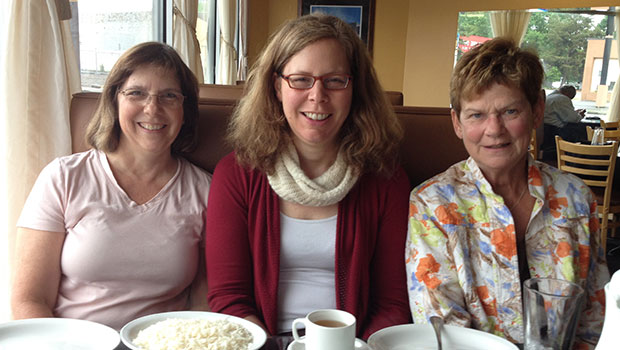Wall Street Journal shines light on our patient researchers

SIMBA study leader Karen Wernli, PhD, with patient investigators Dianne Johnson (left) and Mary Bush (right).
A story in the September 29 Wall Street Journal describes the groundbreaking roles patients are playing in clinical research today—from helping design study questions to selecting which outcomes are most important to measure. Among the few studies selected to highlight this national trend toward patient-centered research is SIMBA (Surveillance Imaging Modalities for Breast Cancer Assessment)—Group Health Research Institute (GHRI)’s ongoing study of breast cancer screening in women who have had the disease before.
SIMBA study leader Karen Wernli, PhD, a GHRI assistant investigator, got the reporter’s call just after she and SIMBA patient investigator Dianne Johnson returned from Stanford Medicine X, the nation’s largest patient-centered conference on emerging technology and medicine. The duo presented an invited talk on September 6 at a workshop on patient engagement hosted by the Patient-Centered Outcomes Research Institute (PCORI), the nonprofit agency that funds SIMBA.
Established in 2010, PCORI supports only research that demonstrates true engagement with patients—a call to action that many researchers have found challenging. At Medicine X, PCORI Engagement Officer Kim Bailey, MS, selected two of the hundreds of studies PCORI has funded to date to help her illustrate the agency’s new Engagement Rubric. This resource was created recently to help researchers truly engage—and center their research on—patients and families.
What’s so special about SIMBA?
How did SIMBA earn a seat on the stage—and a spot in one of the nation’s top newspapers? “Our style of patient engagement really caught PCORI’s attention,” Dr. Wernli explains. “Kim said our project stood out to her because we met many of the criteria in the engagement rubric before it even existed.”
In addition to having two patient investigators and an 11-member patient advisory board, the SIMBA team is visiting three sites across the country to conduct focus groups with women who have had breast cancer to ask about breast imaging after breast cancer treatment. Ms. Johnson and SIMBA’s other patient investigator, Mary Bush, play a lead role in the groups. Susan Brandzel, MPH, SIMBA project manager, facilitates the groups and ensures that Mary’s and Dianne’s presence is understood.
“At our first project check-in meeting with Kim, we were just back from our focus groups in North Carolina with Dianne. We explained how she had amazed us with her ability to connect with the participants,” Ms. Brandzel says. “Without Dianne there, I can’t imagine that Karen and I would have engaged so well with the women who attended. They really felt like she was ‘one of them.’”
“It seems that SIMBA is unique in giving patient investigators a full partnership role in the study, Ms. Johnson adds. “We are consulted about agendas, asked to make presentations, invited to introduce questions at Advisory Board and Stakeholders meetings, and always welcome to give input on the themes and needs we see arising from these discussions. Karen and Susan have us made feel that our roles are equally important as any other person on the research team.”
“All of this has been so rewarding and exciting,” Dr. Wernli says. “And it has all happened really fast, especially for Dianne and Mary.”
“I certainly never imagined that a reporter from the Wall Street Journal would call me to write up our work,” Ms. Johnson says. “The most surprising part is how SIMBA is being recognized by other people who are interested in how we've partnered together—patients and researchers—to make sure study outcomes are as valuable to patients as they are to the medical community.”
What’s next for SIMBA? Another focus group trip to New Hampshire, this time with both Ms. Johnson and Ms. Bush along to help lead the groups. In the meantime, all the women at the September 5 SIMBA Advisory Board meeting were excited to hear about the splash the study was making in the research world.
"It’s a constant learning experience,” Dr. Wernli says. “The conference helped me recognize new ways to use social media to reach special interest groups—like women, families, and caregivers interested in breast cancer. These groups helped us engage other women to get 2,000 answers in a single week to a survey to inform our next study.” She adds: “Even more important, we’ve found a new avenue to get SIMBA results out to the community.”
by Jessica Ridpath

Group Health Research News October 2014
In this issue
- Getting to Goldilocks: 'Just right' breast cancer screening
- Lemonade from lemons: Breast cancer group gains momentum
- Wall Street Journal shines light on our patient researchers
- GHRI names 21 clinical associates
- Nurse-led TEAMcare benefits patients with chronic conditions
- Ultrasound could replace CT scans as first test for kidney stones, lowering radiation



